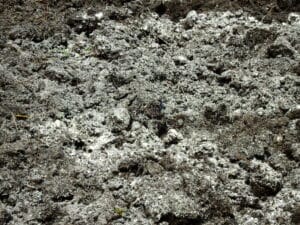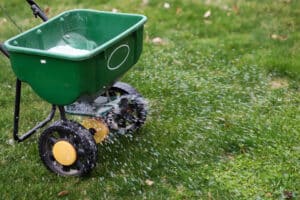Few things are as beautiful or appealing as a yard of bright, yellow dandelions. However, for most homeowners, this also means trouble. Dandelions can be a nuisance and overtake a healthy lawn, making it hard for other plants to sprout and grow. Our guide covers how to kill dandelions, as well as ways to identify dandelion plants and how to prevent their growth.
Find Lawn Help
- See our list of top lawn care companies based on in-depth research.
- Select the company that best meets your needs.
- Get a free, no-obligation quote for your home.
Get a Quote From Lawn Professionals Near You
Compare quotes from local pros
Clicking “Get Your Estimate” submits your data to Home Service Quotes, which will process your data in accordance with the Home Service Quotes Privacy Policy.

Lime Soil Amendment

Lawn Fertilization
How Can You Identify Dandelions in Your Yard?
Dandelion plants are easily identifiable by their bright yellow flowers, but there are many dandelion look-alikes, including sow thistle, false dandelion, and a plant known as cat’s ear.
If you suspect you have dandelions, take a close look at the leaves. Dandelion leaves don’t have fuzz and are deeply toothed, with the leaves and flowers growing out of the rootstock.
Dandelions are among the earliest flowers to bloom in the spring and die off in the hot summer months. They’re perennial weeds that return yearly and live for five to 10 years. They can grow up to 20 inches long, and when the yellow flowers turn into their distinctive fluffy balls and blow seed heads into other parts of your yard, they can easily overtake any green space.

What Are Some Natural Methods for Killing Dandelions?
Some homeowners don’t mind a sprinkling of dandelions in their yards, and some even enjoy the bright yellow pops of color. However, most homeowners prefer to manage the growth of dandelions closely due to their tendency to take over other plants. Below are a couple of natural methods for killing dandelions that are safe for people, pets, and other plants.
Hand-Pulling Dandelions
Hand-pulling dandelions is an effective dandelion removal option if your yard has a few dandelions or if you have extra time to spare. It allows you to remove the entire root and helps prevent regrowth. Always try to pull dandelions when the soil is slightly moist for the best results.
You should also wear gardening gloves when pulling weeds to safeguard against rashes, blisters, and cuts. Additionally, if you opt to pull dandelions by hand, enlist help if possible. Working with a partner can help the project go quickly. Hand-pulling is effective, but it might not be realistic if you’re dealing with a large infestation of dandelions.
Using Natural Herbicides
Natural broadleaf herbicides can help you get rid of dandelions without the time commitment required for hand-pulling. Natural herbicides can be part of any healthy lawn since they don’t include dangerous chemicals that might damage other plants.
You can make a do-it-yourself (DIY) weed killer with corn gluten or boiling water. Vinegar also works well for killing weeds. Fill a clean spray bottle with pure white vinegar and spray it on the dandelion leaves and roots until the plant is entirely saturated. Don’t do this on windy days because the vinegar might drift onto other plants and kill them.
What Are the Chemical Methods for Killing Dandelions?
If natural herbicides aren’t effective or you don’t have time to hand-pull all the dandelions in your yard, you can opt for the following traditional chemical methods.
Pre-Emergent Herbicides
Pre-emergent herbicides prevent the germinating weeds from establishing in your yard. They control weeds by inhibiting cell division in the young root system, resulting in the death of the weed shortly after germination. You should apply pre-emergent herbicides in the early spring, late summer, or early fall for maximum effectiveness.
Post-Emergent Herbicides
Post-emergent herbicides control weeds after germination, traveling down the plant stalk and into the root system to kill the weeds. You can use post-emergent herbicides to kill weeds that are already growing to be truly effective.
Consider calling a professional lawn care service if you aren’t comfortable using chemical herbicides in your yard. A professional can also offer guidance on the right type of herbicide for your dandelion problem and, if necessary, handle the infestation. This is a particularly good option if you don’t have time to test various weed control measures or feel uncomfortable using herbicides.
Ask your friends and family if they have any recommendations for lawn care professionals in your area, and don’t hesitate to read online third-party reviews to narrow your search.
How To Prevent Dandelion Growth
You can control dandelions after they’ve already taken hold in your yard, but preventing dandelion growth is the best way to maintain the pristine lawn of your dreams. Here’s how:
- Fertilize: One way to prohibit dandelion growth is to fertilize your lawn regularly. Nutrient-rich soil supports dense grass growth. Denser grass will help prevent dandelion seeds from taking root and growing.
- Shade them: Dandelions require a lot of sunlight to thrive. Therefore, keeping your grass a little longer can help safeguard against dandelions and other weeds, such as crabgrass and broadleaf perennial weeds.
- Apply mulch: Take time to mulch your lawn. Mulching has various benefits for your yard, including improving soil fertility, injecting nutrients, and preventing weed seeds from germinating. You can mulch by leaving a thin layer of grass clippings in your yard or purchasing some at your local garden center.
Our Conclusion
Dandelions might be lovely to look at, but for most homeowners, they’re a real pain. They can prohibit other plants from growing and quickly take over your yard. Preventing dandelion growth is one of the best ways to safeguard against dandelion infestations, but there are a few natural and traditional chemical methods to remove them. You can also contact a lawn care service for professional help.
FAQs About How To Kill Dandelions
What kills dandelions but not the grass?
The safest way to kill dandelions but not your grass is to hand-pull dandelions by the root. This is a foolproof way to remove dandelion weeds from your yard, but it’s also the most time-consuming. You can also try using natural herbicides. Always read the herbicide labels carefully to see whether the product is safe for your grass and other plants.
How do you permanently kill dandelions?
There are two ways to kill dandelions permanently. These include pulling them up by the root and spraying them with an herbicide. Pulling dandelions is only effective if you remove the entire taproot. The dandelion will come back and blossom again if you only pull the flower or the top portion.
What is the best home remedy to kill dandelions?
The best home remedy to kill dandelions is white vinegar. White vinegar is a natural herbicide that kills many weeds, including dandelions.
What is the best dandelion killer?
The best dandelion killer is usually herbicide. You can opt for either natural or chemical herbicides, but this will also depend on your needs and goals for your lawn. Natural herbicides are gentler. Chemical herbicides are generally more effective but can harm other nearby plants.
Does picking dandelions make them spread?
Picking dandelions doesn’t make them spread unless the seeds scatter on your lawn. The seeds will germinate and grow if they spread. The best way to ensure dandelions don’t spread and grow throughout your yard is to discard them immediately after picking, roots and all.





